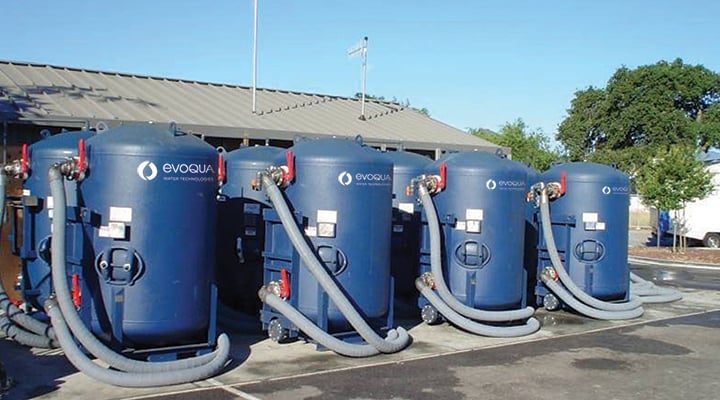Ion Exchange (IX) Systems
See All Short Term Operating ContractMobile and emergency ion exchange solutions to remove organic and inorganic contaminants from water.
- is the minimum order quantity for this product. Please check quantity and add to cart again.

Mobile and emergency ion exchange solutions to remove organic and inorganic contaminants from water.
Description
Mobile and emergency ion exchange solutions to remove PFAS, metals and other inorganic compounds from water.
Ion exchange (IX) is a tried and true method of removing metals and other inorganic compounds from water. Arsenic, cadmium, chromium, copper, lead, nickel, selenium, radionuclides, and zinc are just a few examples of the compounds that our ion exchange systems have removed from water. Ion exchange systems can also be used to remove non-metallic compounds such as ammonia, nitrate, perchlorate, and silicate.
Electrons and protons are subatomic particles. Protons form the nucleus of the atom, and electrons move around the proton. Electrons and protons are electrically charged. Protons are positively charged. The electron has an electrical charge equal to a proton’s charge, but is negative. The protons attract the negatively-charged electrons to form atoms.
Atoms with a positive charge equal to the negative charge are said to be neutral. Sometimes, an atom will lose or gain an electron, and is then in an “ionic state.” An ion is an atom or molecule that is electrically charged. Cations, having has lost a negatively-charged electron, are positively charged. Anions, having gained an electron, are negatively charged. Cations and anions are attracted by their opposite electrical charge. Ion exchange exploits this tendency to pull ions out of a solution. Ionic compounds from a water or solvent stream are captured on the ion exchange media (“resin”).
Dissolved metals often exist in one or more ionic states. An ion-exchange resin has ionically-active sites distributed through its structure. When a solution (water or a different solvent) with dissolved metals passes through a resin bed, the resin attracts and holds oppositely-charged metallic ions by exchanging electrons at these exchange sites.
There are many resins available for removing cations or anions. Some ion exchange media is made from naturally-occurring substances such as zeolite clay. There are also synthetic resins made for specific applications. In general, ion exchange resins can be classified into four groups: 1) strong acidic cation (SAC) exchange resins, 2) weak acidic cation (WAC) exchange resins, 3) strong basic anion (SBA) resins, and 4) weak basic anion (WBA) exchange resins. Evoqua's Evoqua may run lab-scale or pilot tests on the contaminated influent to select the best resin.
A resin bed’s capacity to pull contaminants from a solution is determined by the number of available exchange sites , called “exchange capacity.” When there are several cations or anions are present in water, those cations or anions will compete each other for the exchange sites. When all the exchange sites are used, the resin is “exhausted.” Some resins must be disposed of in a landfill or incinerated.
Some resins can be regenerated and re-used. Regeneration involves passing a regenerant solution over the resin to displace the contaminant ions from the exchange sites. The liberated ions pass from the resin bed into solution. Waste solution generated during regeneration has high levels of contaminants and require safe treatment and disposal.
Evoqua typically uses media vessels for ion exchange treatment. The ion exchange resin is loaded into vessels. The contaminated solution enters the top of the vessel, runs through the resin, which hold the contaminants. The treated water exits the vessel at the bottom. Flow rate through the vessel is regulated by valves to ensure there is enough contact time for the ion exchange to take place.
Other than flow rate, the ion exchange systems effectiveness is largely determined by the influent solution’s chemistry and physical characteristics. Typically, ion exchange works best when the influent’s suspended solids are less than 10 ppm, pH is between 4 and 8, and oil and grease concentrations are low. Pretreatment is often needed before the ion exchange vessels to ensure the most efficient use of the ion exchange resin.
Ion exchange is typically used in concert with other technologies as part of a water treatment system (WTS). An oil-water separator may be needed to remove oil and grease. A carbon vessel may be used to remove hydrocarbons. A settling tank, sand or bag filtration may be needed to reduce the solids. If there are several different contaminants present, a series of vessels, each with different ion exchange resins may be used. Sometimes, pH adjustment may be needed between the different vessels.
Evoqua offers a full range of services to see your project through from beginning to end. Our engineers can design a treatment system best meet the project’s specific needs. Ion exchange media is chosen to remove specific target contaminant chemicals from solution. We deliver and install the media vessels and loads the ion exchange resins into the vessels. If needed, we can design and install equipment to protect the system from freezing. Power is needed to pump water through the resin; if none is available, we can supply a generator. We operate the system on site, or install remote system monitoring and communication so clients and technicians can monitor and control the system from off site or on site.
We have used ion exchange at mine sites, coal-ash ponds, construction sites, remediation sites and in other applications. We provide bench-scale and pilot-scale testing, system design, installation, and operation to meet stringent discharge requirements.
Contact us to find out more and discuss the detail of your project!
Features
Types of Remediation
- Contaminant Removal (1,2,3-TCP, Chrome, MTBE, PCE, Perchloate, PFAS, TCE)
- Heavy Metals Treatment
- Nitrate Removal
- Organics Treatment
